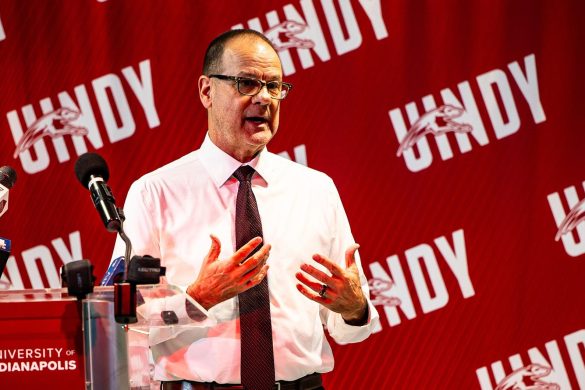The University of Indianapolis plans to invest $50 million in the campus over the next five years. President Robert Manuel announced this five-year plan through campus-wide emails on Feb. 20.
The five-year plan includes relocating UIndy’s health sciences programs into a new facility, then renovating Martin Hall. The plan also would include creating men’s and women’s lacrosse teams, tearing down the Campus Apartments and building student townhouses in their place and renovating Krannert Memorial Library.
According to Vice President and Chief Financial Officer Michael Holstein, the plan was put before the board of trustees on Feb. 14. He said the board scrutinized and had a healthy debate about the plan before eventually approving it.
Holstein said that the funding for this plan will come from three sources—the university’s operating budget, money from real estate investors and the university loaning itself money from its endowment. According to Holstein, the plan will not create any new debt for the university.
Manuel said that the plan’s specific goals were built from the general ideas that came out of Vision 2030 strategic planning sessions. While the Vision 2030 ideas helped create a theory, he said, the plan is how UIndy can put it into practice.
“When I came out in April [2012] to be announced as president … I said, ‘Any progress we make will be tied to the missions and traditions that have animated this university since 1902.’ So the first step in this plan was to figure out what those missions and traditions were,” he said.
Manuel said that ideas that were prevalent in the Vision 2030 sessions, such as student hangouts, small classes and a coffee shop in the library, showed a desire for personal attention and community. He said that the campus lacks these things because the infrastructure is not there. The main idea behind the plan, he said, is to increase the quality of life on and around campus by creating more opportunities for students to interact with each other and faculty members.
“If we don’t do anything to build the physicality of the campus to enable that to happen—personal attention to happen—then our plan isn’t connected,” he said.
Manuel said that the same idea carries over into creating lacrosse teams. He said that the teams will be another recruitment tool to bring in more students, from outside of Indiana, without putting stress on academic programs.
“The demographic shift in Indiana is declining in terms of the number of people graduating from high school,” he said. “Lacrosse is a sport that is really well known in Illinois and Ohio. We can draw and recruit students to campus from those places.”
The lacrosse field will go on space that does not need to be cleared, Manuel said.
Holstein said that unlike the other projects, a real estate developer would be responsible for the funding and construction of the new health sciences facility. The university will then lease the facility from that developer, with the option to buy or continue leasing the facility in the future.
“The ambitious goal is to have it open in August of 2015,” he said. “… And then it’s kind of like a domino effect from there. So once you take the people out of the current facilities and locate them there, then you can do the work in Martin Hall and then you can do the work in the science laboratories.”
Holstein said that he was not at liberty to say where the new health sciences building will be built, but it will be on property that the university already owns. He also said that the university will be responsible for the upkeep of the building.
According to Holstein, though, the new campus apartments would be financed and constructed by the university.
Manuel said that the university would like to increase the student population slightly by creating more programs on both the graduate and undergraduate level. He said that the lacrosse teams also would add about 50 more students per team. However, he said that UIndy would not try to outgrow its small class sizes and personal attention.
“We’re not over-relying on numbers of students coming in but really building capacity for what we have,” he said. “And there are some new hopes that graduate programs might be a piece of that. But again, that will be faculty, department, school driven.”
Manuel said that committees are currently being formed to steer the university through each process. However, he said that things remain fluid, and open to some change.
“There are at least 1,000 moving parts to these projects. Any one of them can change the way it goes. Our commitment is to making it connect to these concepts that came out of the [Vision 2030] strategic plan,” he said. “But we know that we don’t live in a vacuum, and so there are lots of things that can change and make us change our direction. But anything that we do change would be tied to the information and the concepts that we got out of our strategic plan.”








